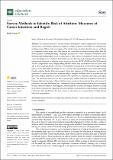Files in this item
Survey methods to identify risk of attrition : Measures of career intention and regret
Item metadata
| dc.contributor.author | Carver, Mark | |
| dc.date.accessioned | 2022-01-06T11:30:05Z | |
| dc.date.available | 2022-01-06T11:30:05Z | |
| dc.date.issued | 2021-10-09 | |
| dc.identifier | 276614065 | |
| dc.identifier | 74a0a238-2926-4841-8b4e-ee61a40bafbe | |
| dc.identifier | 85117322227 | |
| dc.identifier.citation | Carver , M 2021 , ' Survey methods to identify risk of attrition : Measures of career intention and regret ' , Education Sciences , vol. 11 , no. 10 , 617 . https://doi.org/10.3390/educsci11100617 | en |
| dc.identifier.issn | 2227-7102 | |
| dc.identifier.other | ORCID: /0000-0003-4393-8915/work/103138117 | |
| dc.identifier.uri | https://hdl.handle.net/10023/24607 | |
| dc.description | Funding: This research was funded by the Scottish Government through the General Teaching Council for Scotland as part of the Measuring Quality in Initial Teacher Education Project (www. mquite.scot). | en |
| dc.description.abstract | The common measure of teacher retention as snapshots of those employed in state-funded schools may overestimate attrition by failing to consider a desire for flexibility in contemporary teaching careers. When used as a measure of the effectiveness of teacher education, an over-emphasis on classroom teacher supply may also narrow the curriculum to teacher training rather than the more expansive ‘learning teaching’. This paper discusses two ‘softer’ measures of retention, career intention and training regret, to give a more general sense of how contemporary teachers see their career development as relating to their initial teacher education and professional learning. These measures are generated by adapting survey questions from the OECD’s TALIS and the US’ Beginning Teacher Longitudinal Study, simply asking teachers where they see themselves in five years’ time and if they would still choose to become a teacher if they could go back to before they began training. Surveys were administered annually to two cohorts of recent graduates as part of the Measuring Quality in Initial Teacher Education project—three data captures for 2018 graduates, two for 2019 graduates. It is shown how these measures help to mitigate declines in survey response and can give some helpful estimates of teacher attrition with respect to sex, ethnicity, school type, and degree type. The alternative measures are also argued to give helpful indicators of attrition risk before it happens, allowing discussion of how teachers’ career intentions change during their early careers. In particular, it is found that leaving the classroom is a fairly common expectation, but not necessarily because of teacher burnout. It is suggested that asking what teachers can imagine themselves doing is an effective measure for engaging with issues around vocational choice and teaching as a lifelong profession, with implications for how careers in education are conceptualised in initial teacher education programmes. | |
| dc.format.extent | 12 | |
| dc.format.extent | 251956 | |
| dc.language.iso | eng | |
| dc.relation.ispartof | Education Sciences | en |
| dc.subject | Attrition | en |
| dc.subject | Early career teachers | en |
| dc.subject | Initial teacher education | en |
| dc.subject | Teacher retention | en |
| dc.subject | Teachers’ careers | en |
| dc.subject | Wastage rate | en |
| dc.subject | LB Theory and practice of education | en |
| dc.subject | Computer Science (miscellaneous) | en |
| dc.subject | Computer Science(all) | en |
| dc.subject | Education | en |
| dc.subject | Physical Therapy, Sports Therapy and Rehabilitation | en |
| dc.subject | Developmental and Educational Psychology | en |
| dc.subject | Public Administration | en |
| dc.subject | Computer Science Applications | en |
| dc.subject | SDG 4 - Quality Education | en |
| dc.subject.lcc | LB | en |
| dc.title | Survey methods to identify risk of attrition : Measures of career intention and regret | en |
| dc.type | Journal article | en |
| dc.contributor.institution | University of St Andrews. University of St Andrews | en |
| dc.contributor.institution | University of St Andrews. International Education Institute | en |
| dc.identifier.doi | 10.3390/educsci11100617 | |
| dc.description.status | Peer reviewed | en |
This item appears in the following Collection(s)
Items in the St Andrews Research Repository are protected by copyright, with all rights reserved, unless otherwise indicated.

